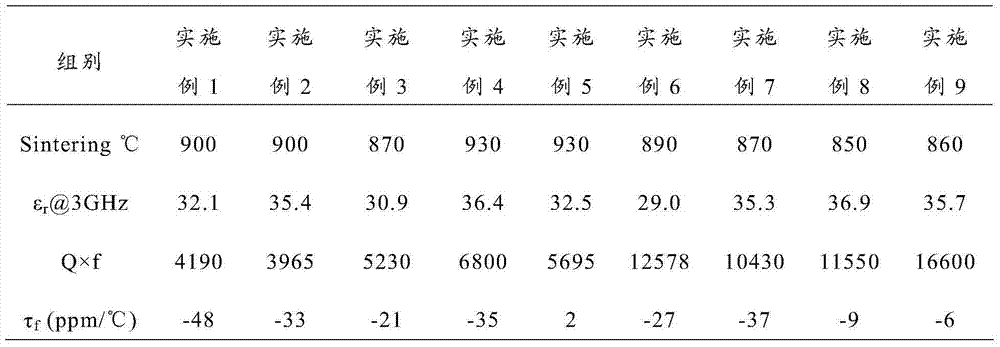Low temperature co-fired ceramic material and preparation method thereof
A technology of low-temperature co-fired ceramics and ceramics, which is applied in the field of electronic devices and can solve problems such as low output, high cost, and complicated ultrafine powder process
- Summary
- Abstract
- Description
- Claims
- Application Information
AI Technical Summary
Problems solved by technology
Method used
Image
Examples
preparation example Construction
[0048] The present invention also provides a preparation method of the above-mentioned low temperature co-fired ceramic material, comprising the following steps:
[0049] BaO, ZnO and TiO 2 mixing, pre-firing after ball milling to obtain ceramic briquettes, and pulverizing the ceramic briquettes to obtain ceramic powder;
[0050] Combine ZnO with B 2 o 3 mixing, pre-calcining after ball milling to obtain a sintered block, melting the sintered block to obtain glass droplets, quenching the glass droplets and pulverizing to obtain Zn-B sintering glass powder;
[0051] ZnO, B 2 o 3 with SiO 2 mixing, pre-calcining after ball milling to obtain a sintered block, melting the sintered block to obtain glass droplets, quenching the glass droplets and pulverizing to obtain Zn-B-Si sintered glass powder;
[0052] BaO, Bi 2 o 3 with SiO 2 mixing, pre-calcining after ball milling to obtain a sintered block, melting the sintered block to obtain glass droplets, quenching the glass dr...
Embodiment 1
[0071] 1mol of BaO powder, 0.25mol of ZnO powder and 2.75mol of TiO 2 powder, and then add deionized water accounting for 80% of the total mass of the above powder, mix evenly and carry out planetary ball milling, the ball milling time is 6h, to obtain the mixed powder; after drying the mixed powder, pre-fire at 1100°C for 6h, to obtain ceramics piece. The ceramics are quickly broken, and the planetary ball milling medium is isopropanol to obtain a ceramic powder of 0.5-3 μm;
[0072] Mix 50g of ZnO powder with 50g of B 2 o 3 Mix the powder, add isopropanol and zirconia balls, and wet ball mill for 12 hours; the glass raw material after ball milling is dried at 120°C after being discharged, and pre-fired at 650°C for 4 hours to become a ceramic material; the ceramic material is added at a temperature of In a crucible at 1500°C, it is rapidly melted into glass droplets and dropped on the cold roller. After cooling and quenching, the amorphous glass-ceramic material with a p...
Embodiment 2
[0076] 1mol of BaO powder, 0.25mol of ZnO powder and 2.75mol of TiO 2 powder, and then add deionized water accounting for 80% of the total mass of the above powder, mix evenly and carry out planetary ball milling, the ball milling time is 6h, to obtain the mixed powder; after drying the mixed powder, pre-fire at 1100°C for 6h, to obtain ceramics piece. The ceramics are quickly broken, and the planetary ball milling medium is isopropanol to obtain a ceramic powder of 0.5-3 μm;
[0077] 40g of Bi 2 o 3 powder, 35g of B 2 o 3 powder with 25g of SiO 2 Mix the powder, add isopropanol and zirconia balls, and wet ball mill for 12 hours; the glass raw material after ball milling is dried at 120°C after being discharged, and pre-fired at 650°C for 4 hours to become a ceramic material; the ceramic material is added at a temperature of In a crucible at 1500°C, it is rapidly melted into glass droplets and dropped on the cold roller. After cooling and quenching, the amorphous glass-...
PUM
| Property | Measurement | Unit |
|---|---|---|
| Particle size | aaaaa | aaaaa |
| Particle size | aaaaa | aaaaa |
| Particle size | aaaaa | aaaaa |
Abstract
Description
Claims
Application Information
 Login to View More
Login to View More - R&D
- Intellectual Property
- Life Sciences
- Materials
- Tech Scout
- Unparalleled Data Quality
- Higher Quality Content
- 60% Fewer Hallucinations
Browse by: Latest US Patents, China's latest patents, Technical Efficacy Thesaurus, Application Domain, Technology Topic, Popular Technical Reports.
© 2025 PatSnap. All rights reserved.Legal|Privacy policy|Modern Slavery Act Transparency Statement|Sitemap|About US| Contact US: help@patsnap.com

